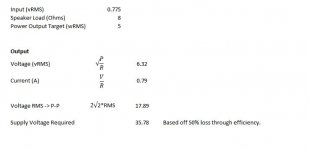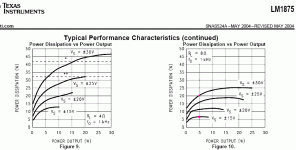Hi Guys,
Just looking for some help with the power supply requirements on a LM1875 based amp im trying to plan. Currently my plan is to use a unipolar supply biased. I've come up with the below and i was wondering if I was correct or if i was just confusing myself.
Audio Signal Voltage : 0.775vRMS
Speaker / Load Resistance: 8 ohm
Efficiency Assumption: 50%
Continuous Power: 5w
Am I on the right track in saying to achieve 5w @ 8 ohms with a 50% efficient amplifier i would require a 36v supply which would source just under 1 amp of current to avoid it from clipping?
I also know that the LM1875 needs a closed loop gain of 10x to stay stable, but I can attenuate before the amplifier to reduce in input signal to achieve a power target.
Just looking for some help with the power supply requirements on a LM1875 based amp im trying to plan. Currently my plan is to use a unipolar supply biased. I've come up with the below and i was wondering if I was correct or if i was just confusing myself.
Audio Signal Voltage : 0.775vRMS
Speaker / Load Resistance: 8 ohm
Efficiency Assumption: 50%
Continuous Power: 5w
Am I on the right track in saying to achieve 5w @ 8 ohms with a 50% efficient amplifier i would require a 36v supply which would source just under 1 amp of current to avoid it from clipping?
I also know that the LM1875 needs a closed loop gain of 10x to stay stable, but I can attenuate before the amplifier to reduce in input signal to achieve a power target.
Attachments
...Am I on the right track ...
No.
Even if efficiency could be as bad as 50%, how could 5 Watts out need 25 Watts in?
There’s obviously something fundamental that im tripping over.
Can someone see where im going wrong with the working out below?
Power - 5w Continuous/RMS
Impedance - 8ohm
Voltage - Sqrt(PxR) -> Sqrt(40) = 6.32v RMS
Current - V/R -> 6.32/8 = 0.79A RMS
As I’m using a Unipolar supply of 24v I’ll convert the 6.32RMS to peak to peak to make sure when it's biased @ 12v it wont hit either of the supply rails on the + or - swings
Output Voltage p-p = 17.876v
+50% for Power losses = 26.814v
So I realised I’d doubled the voltage, not done an extra 50% (i know the AB class is better, but just for worse case).
If this again is completely off the pace does my working show where my understanding might be lacking?
**Note - After ive typed this I realised. Volts RMS is the average DC equivalent, so the conversion to P-P in erroneous?**
Sorry if this is frustratingly simple and I’m over complicating it.
Can someone see where im going wrong with the working out below?
Power - 5w Continuous/RMS
Impedance - 8ohm
Voltage - Sqrt(PxR) -> Sqrt(40) = 6.32v RMS
Current - V/R -> 6.32/8 = 0.79A RMS
As I’m using a Unipolar supply of 24v I’ll convert the 6.32RMS to peak to peak to make sure when it's biased @ 12v it wont hit either of the supply rails on the + or - swings
Output Voltage p-p = 17.876v
+50% for Power losses = 26.814v
So I realised I’d doubled the voltage, not done an extra 50% (i know the AB class is better, but just for worse case).
If this again is completely off the pace does my working show where my understanding might be lacking?
**Note - After ive typed this I realised. Volts RMS is the average DC equivalent, so the conversion to P-P in erroneous?**
Sorry if this is frustratingly simple and I’m over complicating it.
Amplifier power supplies are a little complicated by output stage.
If its bipolar then you can get down to 0.2 volts across output transistor.
With mosfets it can be a few volts.
So power supply needs to be lifted a bit to make up for that.
Class AB is about 60% efficient so your power in needs to be about double what the speaker needs.
Having said all that, music isnt always full power square waves so some manufacturers rely on that to skimp on power supplies a bit.
The power supply needs more volts or more current depending on speaker impedance.
High impedance needs more volts and lower impedance more current.
If its bipolar then you can get down to 0.2 volts across output transistor.
With mosfets it can be a few volts.
So power supply needs to be lifted a bit to make up for that.
Class AB is about 60% efficient so your power in needs to be about double what the speaker needs.
Having said all that, music isnt always full power square waves so some manufacturers rely on that to skimp on power supplies a bit.
The power supply needs more volts or more current depending on speaker impedance.
High impedance needs more volts and lower impedance more current.
5 wrms into 8 ohms.
Vrms = sqr root (power * resistance) so 6.3 vrms as you say. 6.3* 1.414 gives the peak which is approx 9.
Peak to peak is 9 multiplied by 2 which is 18.
Minimum supply needed is 18v plus loses in the amplifier. A single rail 24 volt dc covers it easily.
Peak current is 9 (the peak voltage) divided by 8 ohm which is 1.125 amp
Average current is peak current divided by Pi which is 0.36 amps.
That gives you something to work to for picking a power supply. Allowing for losses and a safety margin a 0.5 amp 18 volt transformer (so 9va rating) should be suitable.
Vrms = sqr root (power * resistance) so 6.3 vrms as you say. 6.3* 1.414 gives the peak which is approx 9.
Peak to peak is 9 multiplied by 2 which is 18.
Minimum supply needed is 18v plus loses in the amplifier. A single rail 24 volt dc covers it easily.
Peak current is 9 (the peak voltage) divided by 8 ohm which is 1.125 amp
Average current is peak current divided by Pi which is 0.36 amps.
That gives you something to work to for picking a power supply. Allowing for losses and a safety margin a 0.5 amp 18 volt transformer (so 9va rating) should be suitable.
....over complicating it.
The datasheet has the data in graphs.
8Ω. Find 5W. The chip can do 5W with just +/-15V (30V total). At that point it will dissipate 7 Watts. The efficiency is less than 50%! Mostly because 5W is not using all of the 30V. It can be run out to 8 or 9 Watts and over 50% eff. Alternatively it can be run on 24V total supply, still make 5W output, at (interpolating) maybe 4W dissipation. (Fig 5 shows +/-11V may work.)
Don't take the "efficiency" off the supply voltage. The theoretical 78% for sine class B comes from the difference between steady DC supply and rounded sine waveform. In a real amp you lose a few more volts in the devices. But not half, not 1.414.
There's a shortcut. Took a few years to satisfy myself on it. A clean transistor B amp on 8Ω load, sine, "looks like" 48Ω to the power supply. So a 24V supply must deliver 0.5 Amps. Multiply the load by 6 and hang that resistor on the supply, that's the equivalent load. Driving 600Ω to full +/-15V sine? Figure (30/(600*6))= 8mA on top of the amp idle current. Bridge into 4Ω on 12V power? Each side sees 2Ω, so 12Ω, twice, is 6Ω, and makes 24 Watts DC load. As the true audio power is not quite 18W, it figures as 75% efficiency, close enough for boom-cars.
I suspect "6" is more like "2 pi" but we never have to be that precise.
Attachments
- Home
- Amplifiers
- Power Supplies
- PSU Calculation

